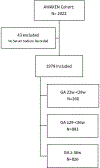Association of early dysnatremia with mortality in the neonatal intensive care unit: results from the AWAKEN study
- PMID: 34775486
- PMCID: PMC10228559
- DOI: 10.1038/s41372-021-01260-x
Association of early dysnatremia with mortality in the neonatal intensive care unit: results from the AWAKEN study
Abstract
Objective: To determine the association of dysnatremia in the first postnatal week and risk of acute kidney injury (AKI) and mortality.
Study design: A secondary analysis of 1979 neonates in the AWAKEN cohort evaluated the association of dysnatremia with (1) AKI in the first postnatal week and (2) mortality, utilizing time-varying Cox proportional hazard models.
Result: Dysnatremia developed in 50.2% of the cohort and was not associated with AKI. Mortality was associated with hyponatremia (HR 2.15, 95% CI 1.07-4.31), hypernatremia (HR 4.23, 95% CI 2.07-8.65), and combined hypo/hypernatremia (HR 6.39, 95% CI 2.01-14.01). In stratified models by AKI-status, hypernatremia and hypo/hypernatremia increased risk of mortality in neonates without AKI.
Conclusion: Dysnatremia within the first postnatal week was associated with increased risk of mortality. Hypernatremia and combined hypo/hypernatremia remained significantly associated with mortality in neonates without AKI. This may reflect fluid strategies kidney injury independent of creatinine and urine-output defined AKI, and/or systemic inflammation.
© 2021. The Author(s), under exclusive licence to Springer Nature America, Inc.
Conflict of interest statement
Conflict of Interest:
Dr. Abby Basalely has consulted for impact communication partners. Dr. Kimberly Reidy is site investigator for Advicenne and Travere Therapeutics clinical trials unrelated to this study. Dr. Jennifer Charlton is co-owner of Sindri Technologies LLC. Dr. David J Askenazi declares no real or perceived conflicts of interest that could affect the study design, collection, analysis and interpretation of data, writing of the report, or the decision to submit for publication. He does have the following commitments and funding sources that are not directly related to this study: David J Askenazi serves on the speaker board for Baxter (Baxter, USA), and the Acute Kidney Injury (AKI) Foundation (Cincinnati, OH, USA). David J Askenazi is a consultant for CHF solutions, and Medtronic.
Figures


References
-
- Sakr Y, Rother S, Ferreira AM, Ewald C, Dunisch P, Riedemmann N, et al. Fluctuations in serum sodium level are associated with an increased risk of death in surgical ICU patients. Crit Care Med 2013, 41(1): 133–142. - PubMed
Publication types
MeSH terms
Substances
Grants and funding
LinkOut - more resources
Full Text Sources

